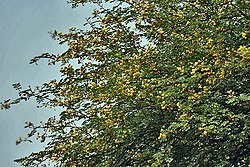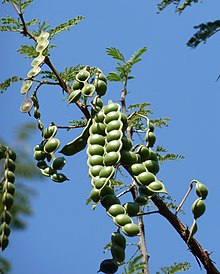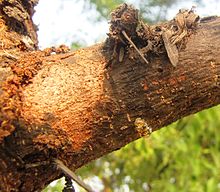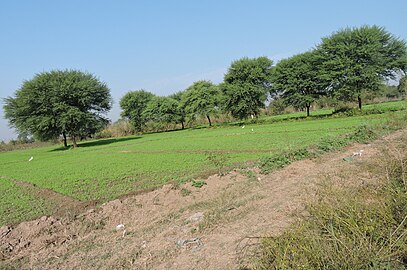Vachellia nilotica (commonly known as gum arabic tree, babul, thorn mimosa, Egyptian acacia or thorny acacia) is a flowering plant tree in the family Fabaceae. It is native to Africa, the Middle East and the Indian subcontinent. It is also a Weed of National Significance in Australia (an invasive species of significant concern in Australia,) as well as a Federal Noxious Weed in the United States.
Taxonomy
This tree was originally the type species of the genus Acacia, which derives its name from Ancient Greek: ἀκακία, akakía, the name given by early Greek botanist-physician Pedanius Dioscorides (ca. 40–90) to this tree as a medicinal, in his book Materia Medica. The renaming of the genus to Vachellia remains controversial.
The genus name Acacia derives from the Ancient Greek word for its characteristic thorns, ἄκις, ákis, “thorn”. The species name nilotica was given by Linnaeus from this tree’s best-known range along the Nile river. The plant V. nilotica then, in turn, became the type species for the Linnaean genus Acacia (not all of which have thorns, even though they are named for them). For the ongoing reclassification of this and other species historically classified under genus Acacia, see the Acacia.
Description

Spring blossoms at Hodal in Faridabad District of Haryana, India
Vachellia nilotica is a tree 5–20 m high with a dense spheric crown, stems and branches usually dark to black coloured, fissured bark, grey-pinkish slash, exuding a reddish low quality gum. The tree has thin, straight, light, grey spines in axillary pairs, usually in 3 to 12 pairs, 5 to 7.5 cm (3 in) long in young trees, mature trees commonly without thorns. The leaves are bipinnate, with 3–6 pairs of pinnulae and 10–30 pairs of leaflets each, tomentose, rachis with a gland at the bottom of the last pair of pinnulae. Flowers in globulous heads 1.2–1.5 cm in diameter of a bright golden-yellow color, set up either axillary or whorly on peduncles 2–3 cm long located at the end of the branches. Pods are strongly constricted, hairy, white-grey, thick and softly tomentose. Its seeds number approximately 8000/kg.
Distribution
Vachellia nilotica is native from Egypt, across the Maghreb and Sahel, south to Mozambique and KwaZulu-Natal, South Africa, and east through the Arabian Peninsula to the Indian Subcontinent subcontinent and Burma. It has become widely naturalised outside its native range including Zanzibar and Australia. Vachellia nilotica is spread by livestock.
Uses

Seed pods

Gum Arabic exuding

Trunk at Hodal in Faridabad District of Haryana, India
Forage and fodder
In part of its range smallstock consume the pods and leaves, but elsewhere it is also very popular with cattle. Pods are used as a supplement to poultry rations in India. Dried pods are particularly sought out by animals on rangelands. In India branches are commonly lopped for fodder. In West Africa, the pods and leaves are considered to have anthelminthic properties on small ruminants and this has been confirmed by in vitro experiments on nematodes.
Tooth brushing
The tender twig of this plant is used as a toothbrush in south-east Africa, Indian subcontinent.
Gum arabic
The exudate gum of this tree is known as gum arabic and has been collected from the pharaonic times for the manufacture of medicines, dyes and paints. In the present commercial market, gum arabic is defined as the dried exudate from the trunks and branches of Senegalia (Acacia) senegal or Vachellia (Acacia) seyal in the family Leguminosae (Fabaceae).:4 The gum of A. nilotica is also referred to in India as Amaravati gum.
Lumber
The tree’s wood is “very durable if water-seasoned” and its uses include tool handles and lumber for boats. The wood has a density of about 833 kg/m3.
Food and medicine
In India it’s used as a ingredient in various dishes.
The Maasai people eat both the inner bark (phloem) and the fruit pulp boiled in water. They also use this plant medicinally to treat sore throat, cough, chest pains etc.
In Northern Nigeria it is called bagaruwa in Hausa. Medicinal uses include soaking the tender bark in water to be taken against dysentery and pile. The fruits are grinded together with the seeds and taken with honey as treatment against stomach ulcers.
Propagation
There are 5000–16000 seeds/kg.
Gallery
-
Vachellia nilotica, Village Behlolpur, Punjab, India
-
village Chaparr Chirri, Mohali, Punjab, India
-

Compound leaf, seed, flower and seed pod


